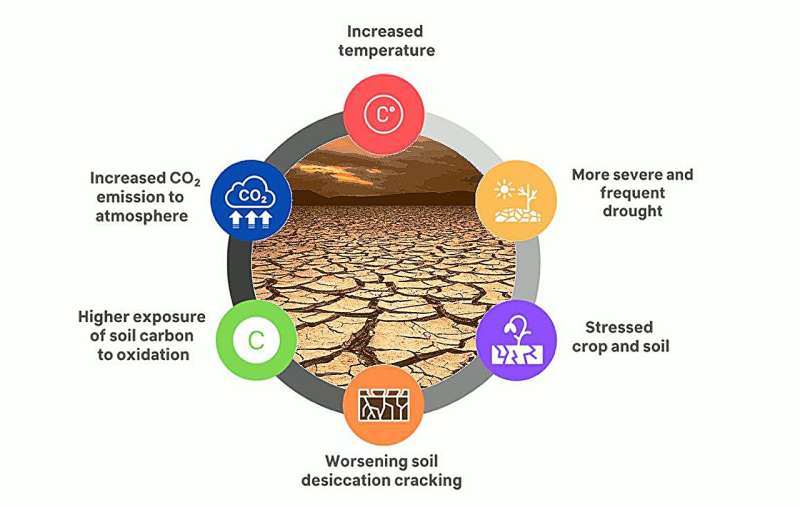This article has been reviewed according to Science X's editorial process and policies. Editors have highlighted the following attributes while ensuring the content's credibility:
fact-checked
trusted source
proofread
Soil may release more carbon than expected, affecting climate change models

The accuracy of climate models depends on many factors—greenhouse gas emissions from industrial and transportation activity, farm animal "emissions," urban growth and loss of forests, and solar reflections off snow and ground cover. Natural phenomena like volcanic eruptions also contribute and are incorporated into models.
But some other natural processes have been overlooked. Farshid Vahedifard, professor and Louis Berger Chair in civil and environmental engineering, points to an important one that lies directly beneath our feet and covers most of our planet above water.
In a study published in Environmental Research Letters, Vahedifard notes that soil stores 80% of carbon on Earth, and with increasing cycles and severity of droughts in several regions, that crucial reservoir is cracking and breaking down, releasing even more carbon dioxide and other greenhouse gases into the atmosphere. In fact, it may be creating an amplified feedback loop that could accelerate climate change well beyond current predictions.
"This process has not been sufficiently evaluated in the existing literature or incorporated into models," said Vahedifard. "If we don't consider the interplay of drought, soil desiccation cracking, and CO2 emissions, that could result in significant inaccuracies when modeling and predicting climate change. There are other repercussions as well. Poorer soil health can lead to reduced photosynthesis and lower carbon dioxide uptake, and it can compromise the structural integrity of earthen dams that protect against floods."
There are also other amplifying feedback loops that may not have been fully accounted for in climate change models, he said. These include melting of sea ice and exposure of darker ocean surfaces that absorb more heat from the sun. The increase of wildfires due to warm, dry conditions releases a lot of carbon dioxide into the atmosphere, which in turn creates hotter, drier weather more conducive to fires.
Another amplified feedback loop is the thawing of Arctic and sub-Arctic permafrost, which also releases carbon dioxide into the atmosphere and raises climate temperature, leading to more melted permafrost.
But soil changes caused by drought could be as significant, if not more significant, than any of those factors. Drought, manifested by long periods of low soil moisture content and high temperature, leads to cracking in fine-grained soils, sometimes extending meters below the surface. The cracks result in more exposure to the air, increased microbial activity and breakdown of organic matter, releasing carbon dioxide, and loss of nutrients and ability to support plant growth, reducing carbon dioxide sequestering.
The deep cracks expose much older reserves of carbon that had previously been stable and protected, Vahedifard said. The permeation of air into the soil accelerates the release of not only carbon dioxide from organic matter but also other greenhouse gases like nitrous oxide.
Small animals like earthworms and millipedes that help turn the soil over are also affected by the reduced moisture and increased air exposure, being less able to play active roles in nutrient cycling and soil structure maintenance. That, in turn, increases the likelihood of soil cracking and aeration.
"The amplifying effect of soil carbon feedback loops and its interactions with other loops could carry us across tipping points and lead to even more severe and permanent shifts in climate," said Vahedifard.
He noted that government agencies and policymakers need to promote sustainable land use, "which can include adoption of precision irrigation techniques and water conservation practices, and use of drought tolerant crops," he said. "Organic fertilizers and compost can enhance soil organic matter content and improve soil water-holding capacity. Of course, this can only help if it's part of a comprehensive effort to reduce greenhouse gas emissions from all human activity."
More information: Farshid Vahedifard et al, Amplifying feedback loop between drought, soil desiccation cracking, and greenhouse gas emissions, Environmental Research Letters (2024). DOI: 10.1088/1748-9326/ad2c23
Provided by Tufts University





















